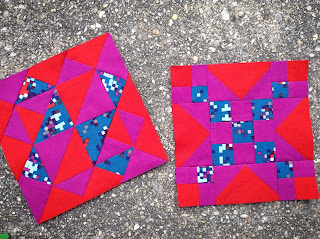Jay McCarrol's Habitat City Planning in teal
Michael Miller Cotton Couture in Jewel and Paprika.
Kerry asked me to post my version of a block last February. At that time, I decided to make this quilt with vivid color in a single value. After making that first block, I pored over my stash to find prints from my stash that could work. Then I dug through my solids color cards for Kona and Michael Miller Cotton Couture and ordered all of the vivid solids in that value.
At the DCMQG guild meeting this weekend I cut and pieced a few different sampler blocks.
My first version of Mrs. Lloyd
Jenny
Aunt
Caroline
For the Mrs. Lloyd block, I didn't do anything fancy with the piecing. I measured the templates to cut the squares and pieced them. For the flying geese portions of the block I used the rectangle and two squares method to make them. I did use a lot of starch because starch is my best friend when it comes to precision piecing. As I mentioned in previous posts, Michael Miller Cotton Couture and starch don't always get along. I used a liberal amount of liquid starch on the fabrics before cutting. Then after piecing I only used a spray bottle with a mix of vodka water to get crisp pressing of seams.
It turns out that I'm not loving the single value and vivid color look in fabric combinations other than my original three. I'm not sure why.
Some experiments are good to stick with and follow through to the end. And some are not. I remade the Mrs. Lloyd block with my original fabrics. Now I'm changing my sampler plan to using only three fabrics. (!!!) If you know me at all, limiting my palette to three is crazy hard. I think this could be a fun new experiment. Eventually I hope to share more about it here.
If you haven't started the Farmer's Wife 1930's Quilt Along, join in now! I only have two blocks done so it won't take long to catch up to me! Don't forget to tag
your Farmer's Wife blocks on Instagram with the hashtag #fw1930sqal,
and tell me about your sewing experiments in the comments.












